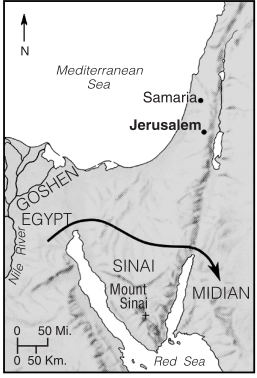
Moses Flees from Egypt to Midian
After murdering an Egyptian, Moses escaped into Midian. There he married Zipporah and became a shepherd.
Open Bible Data Home About News OET Key
OET OET-RV OET-LV ULT UST BSB MSB BLB AICNT OEB WEBBE WMBB NET LSV FBV TCNT T4T LEB BBE Moff JPS Wymth ASV DRA YLT Drby RV SLT Wbstr KJB-1769 KJB-1611 Bshps Gnva Cvdl TNT Wycl SR-GNT UHB BrLXX BrTr Related Topics Parallel Interlinear Reference Dictionary Search
A B C D E F G H I J K L M N O P Q R S T U V W XY Z
MIDIAN, MIDIANITE
Person, place, or people, the latter living on the eastern edge of Gilead, Moab, and Edom south into northwest Arabia. They had few, if any, permanent settlements.
Midian and his descendants figure prominently only in the early history of Israel, in connection with Abraham (Gn 25:1-6), Joseph (37:25-36), Moses (Ex 2:15–3:1), Balaam (Nm 22:1-6; 25; 31:1-20), and Gideon (Jgs 6:1–8:28).
Midian was Isaac’s younger half brother, the fourth of six sons born to Keturah, whom Abraham married as an old man (Gn 25:1-2; cf. 23:1-2; 24:67; 1 Chr 1:32). By calling Midian and his full brothers “the sons of Keturah” (Gn 25:4; 1 Chr 1:32-33), the Bible carefully distinguishes them from Isaac, the son of Sarah, who was the one through whom God’s promise to Abraham would be fulfilled (Gn 12:1-3; 17:15-21). In fact, Abraham and the Israelites regarded these other sons as having no more inheritance rights than a concubine’s sons (Gn 25:5-6; 1 Chr 1:31).
Expelled from Abraham’s family, for Isaac’s sake, they became seminomadic peoples of the deserts east and south of Palestine (Gn 25:5-6).
The Land of Midian
Of uncertain location, Midian was probably far south of Edom on the eastern side of what is today called the Gulf of Aqaba. The Alexandrian geographer Ptolemy (second century AD) mentions a city named Modiana on the coast and a Madiana 26 miles (41.8 kilometers) inland (modern el-Bed’) in this region, an identification supported by the Jewish historian Josephus (first century AD) and the Christian church historian Eusebius (early fourth century).

Moses Flees from Egypt to Midian
After murdering an Egyptian, Moses escaped into Midian. There he married Zipporah and became a shepherd.
In early OT times Midian seems to have been the land on the edge of the deserts bordering Gilead, Moab, and Edom south even into eastern Sinai.
In Joseph’s day, some Midianite clans must have lived in the northern Transjordanian desert adjacent to Gilead or Bashan because they were part of an Ishmaelite caravan traveling the trade route from Damascus across Gilead past Dothan to Egypt (Gn 37:17, 25-28, 36).
When Moses fled from Pharaoh, he settled in Midian and eventually married Zipporah, the daughter of a Midianite priest (Ex 2:15-22). Moses asked his Midianite relative Hobab to act as a guide from Horeb to Kadesh-barnea (Dt 1:19); Hobab was familiar with the wilderness of Paran (Nm 10:11-12, 29-31), even though his own land and relatives were elsewhere (v 30).
In the Balaam episode and its bloody aftermath (Nm 22:31), a substantial group of Midianites appears to have been living on the eastern frontier of Moab. The Moabite king Balak, who was subject to the Amorite king named Sihon (21:26-30; Jer 48:45), discussed the Israelite threat with the elders of Midian, and a joint delegation was sent to Balaam (Nm 22:2-7). At Acacia in the plains of Moab (Nm 22:1; 25:1), an Israelite met and married a Midianite princess (Nm 25:6-18; 31:8). The Midianite kings were considered puppet kings of King Sihon (Jos 13:21). All the indications are that Midianite clans lived nearby, on the borders of Moab. Since Moab is north of Edom, the reference to an Edomite victory over Midian (Gn 36:35) might indicate a northern encroachment by the Midianites on Edomite territory.
The Midianite invasion that Gideon repulsed had all the appearances of an invasion from the east. It would therefore seem that while “the land of Midian” is a term that may refer to a territory south of Edom, Midianites were living over a much wider area—on marginal land—east of Moab and Edom and south of Edom into east Sinai and northwest Arabia.